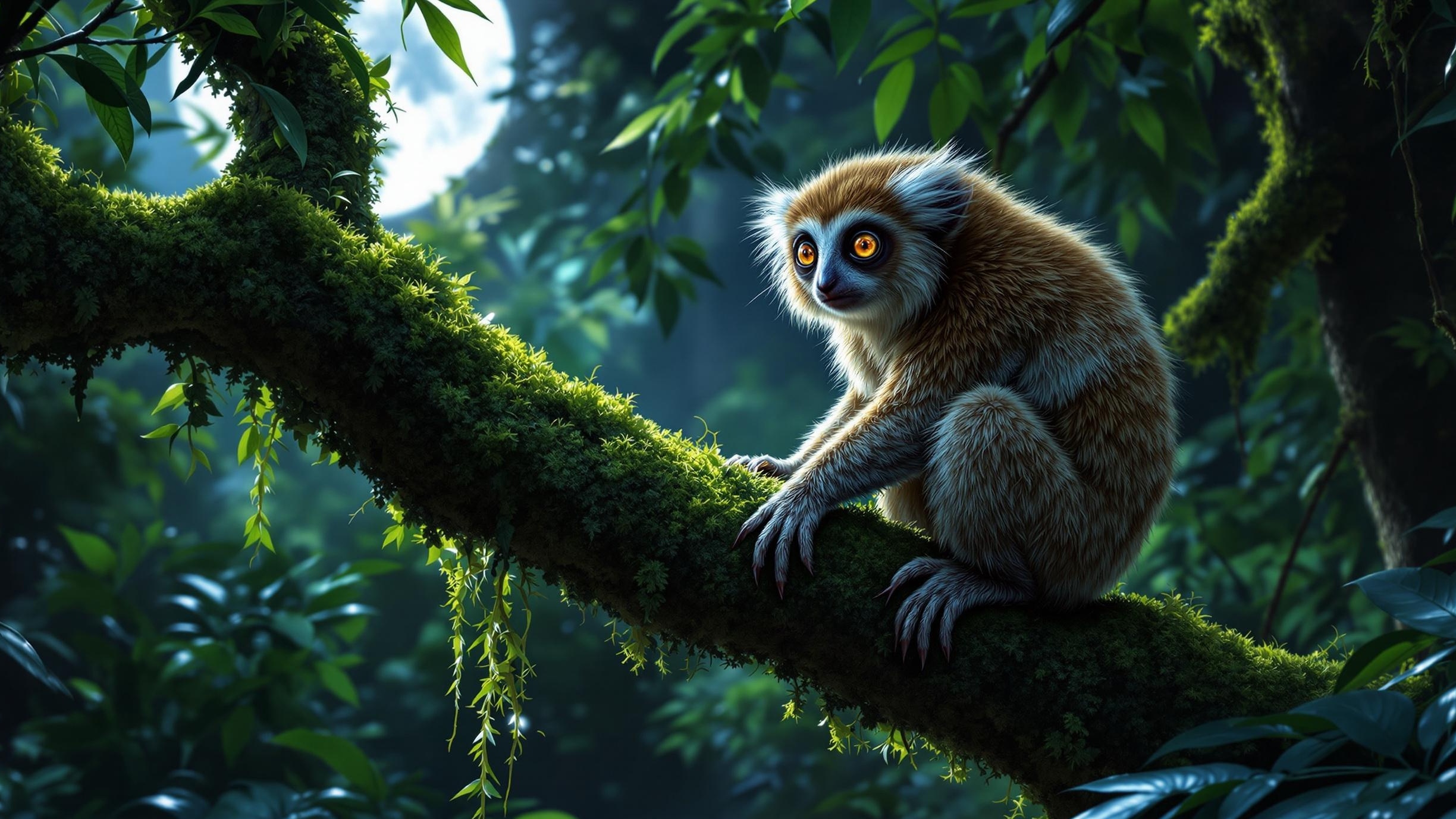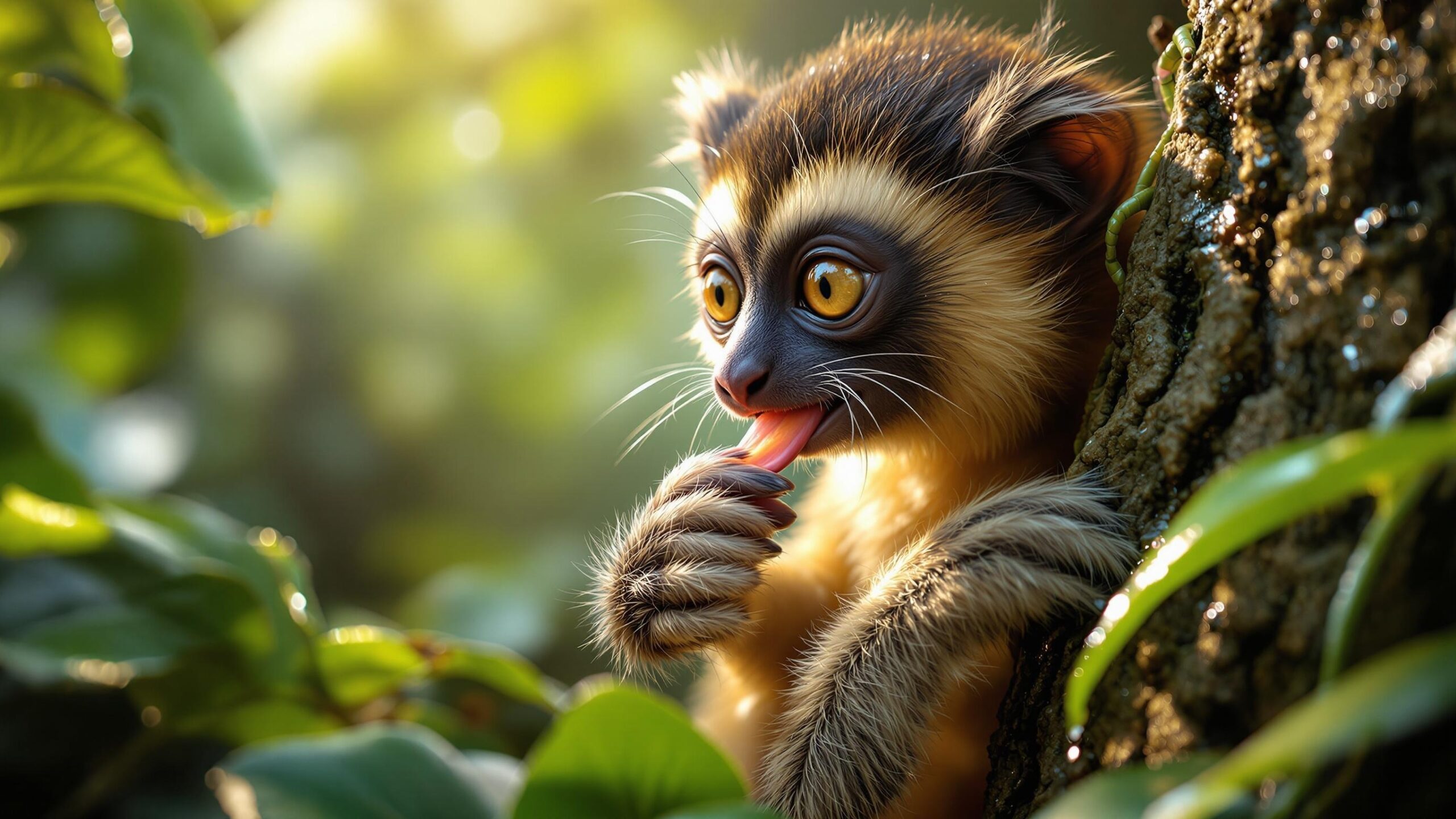The Enigmatic Slow Loris: Nature’s Nocturnal Acrobat
In the hush of twilight across Southeast Asia’s dense tropical forests, a wide-eyed, fuzzy creature begins its silent descent through the canopy. Its movements are unhurried, calculated, and nearly imperceptible. This is the slow loris, a primate so peculiar and mysterious that it defies the expectations typically associated with monkeys and apes. Belonging to the genus Nycticebus, the slow loris is a rare blend of adorable appearance, stealthy demeanor, and hidden danger. Behind its button-like eyes and cuddly exterior lies one of the most unique mammals in the world.
Slow lorises are strepsirrhine primates, a suborder of primates often referred to as “wet-nosed” primates, which also includes lemurs and galagos. Unlike their energetic and vocal relatives, slow lorises take life at a different rhythm—quiet, deliberate, and largely in the shadows. Yet their lives are packed with fascinating behaviors, evolutionary secrets, and surprising adaptations that have long fascinated primatologists and wildlife lovers alike.
A Look into the Species
The term “slow loris” encompasses several species within the genus Nycticebus, including the Sunda slow loris (Nycticebus coucang), Bengal slow loris (Nycticebus bengalensis), Javan slow loris (Nycticebus javanicus), pygmy slow loris (Nycticebus pygmaeus), and a few others. Each species has its own geographic range and subtle differences in behavior and physiology, but all share a distinctive blend of features: a round face, large forward-facing eyes adapted for night vision, a soft and dense coat, and a slow, almost hypnotic gait.
Native to regions stretching from Northeast India to the Philippines, slow lorises occupy diverse habitats including rainforests, bamboo groves, and mangroves. Despite regional differences, all species are arboreal and nocturnal, spending their lives among the treetops and venturing out under the cover of night.
Evolutionary Oddity: Toxic Primate
One of the most striking and scientifically fascinating traits of the slow loris is its venomous bite—a rarity among mammals and the only known case among primates. Glands located in their upper arms secrete a toxin that the loris licks or rubs onto its teeth. When it bites, this venom is transferred into the wound. While not deadly to humans, the bite can cause extreme pain, swelling, and even anaphylactic shock in some cases.
The evolutionary purpose of this venom is still a topic of research, but theories suggest that it plays a role in both predator defense and intraspecific competition. Mothers have been observed coating their offspring’s fur with the toxin to deter predators, and fights between males often end in serious injury due to venom-infused bites. For such a slow-moving animal, this biological weapon provides an unexpected edge in the treacherous wild.
Big Eyes in the Night: Adaptations for Nocturnal Living
The most iconic feature of the slow loris is undoubtedly its enormous, round eyes. These are not merely an aesthetic trait but a biological adaptation to its nocturnal lifestyle. Packed with rod cells, the eyes allow exceptional night vision, enabling lorises to navigate and hunt in pitch-black forest understories.
Unlike many primates, slow lorises lack a tapetum lucidum—the reflective layer behind the retina that enhances low-light vision. Instead, their visual system is optimized in other ways. Their movements are slow and quiet, which complements their enhanced hearing and tactile sensitivity. Lorises use scent-marking and vocalizations to communicate with one another in the dark, although much of their life remains cloaked in mystery due to their elusive habits.
Diet and Foraging Behavior
Slow lorises are omnivorous but lean toward an insectivorous and gumivorous diet. They consume a variety of food including fruits, tree gum, nectar, insects, small reptiles, and bird eggs. Their powerful jaws and specialized teeth—particularly a structure known as the toothcomb—allow them to scrape tree bark to access sap and gum, which can form a significant part of their diet.
Tree gum is especially important for some species like the pygmy slow loris, and the animals have evolved digestive systems capable of processing this sticky substance. Their slow metabolism complements this diet, allowing them to survive on lower-energy food sources over long periods.
Foraging is a solitary activity. Lorises use their strong hands and feet to maintain a vice-like grip on branches as they stretch, reach, and move from tree to tree in search of food. Their quiet and calculated foraging makes them nearly invisible in their nighttime environment.
Social Structure and Reproduction
Although often considered solitary, slow lorises do form loose social networks. Their territories may overlap, and individuals often communicate through scent marking, ultrasonic calls, and even facial expressions. Male territories typically overlap with those of several females, suggesting a polygynous mating system.
Breeding can occur throughout the year, though peak mating seasons vary by region. The gestation period lasts about six months, after which a single infant is born. Slow loris mothers are attentive caregivers, and the infant clings tightly to its mother for several weeks. Remarkably, when the mother needs to forage, she may “park” her infant on a branch and coat it in venom as a form of protection. This behavior is a fascinating intersection of parenting and defense, rarely seen in other primates.
Infants mature slowly, weaning after about six months and reaching sexual maturity between 18 months and two years. The slow loris’s long developmental period is yet another aspect of its slow-paced life, but it also makes the species vulnerable to population decline.
The Silent Acrobat
Despite their deliberate pace, slow lorises are incredibly adept climbers. Their strong grip, flexible joints, and muscular limbs allow them to perform feats of arboreal gymnastics—albeit in slow motion. This mode of locomotion, known as “quadrumanous climbing,” involves the use of all four limbs in a careful, coordinated manner, enabling the loris to move without making noise or attracting attention.
This stealthy movement is a form of crypsis, an anti-predator adaptation. By remaining motionless or moving slowly, the slow loris avoids detection by predators such as snakes, civets, raptors, and humans. The strategy seems to be working—at least evolutionarily—as it has persisted through millennia. However, modern threats are proving to be far more disruptive than natural predators.

Threats in the Modern World
The slow loris faces a suite of challenges in today’s world, many of which stem from human activity. Habitat destruction due to logging, agriculture, and urban development is among the most pressing issues. As forests shrink and fragment, lorises lose their homes and the corridors that allow them to safely forage and reproduce.
Another significant threat is the illegal wildlife trade. Slow lorises are often captured for the exotic pet market or used in traditional medicine. Their cute appearance makes them especially vulnerable, as they are frequently misrepresented in viral videos and social media posts. These portrayals fuel demand for pet lorises, despite the fact that they do not fare well in captivity and are protected under international law.
To make them appear more docile, traders often remove the loris’s front teeth—an act that causes immense pain, leaves the animal vulnerable to infection, and renders it unable to survive in the wild if released. Many die before they even reach a buyer.
While conservation organizations and governments have increased efforts to curb this trade and protect the species, enforcement remains uneven, and education is critical to changing public perception and reducing demand.
Conservation and Hope for the Future
Slow lorises are listed under Appendix I of CITES, meaning international trade is strictly prohibited. Several species, such as the Javan slow loris, are classified as Critically Endangered by the IUCN due to rapid habitat loss and illegal capture. Others, like the pygmy and Bengal slow lorises, are listed as Endangered or Vulnerable.
Numerous NGOs and research institutions are working to study slow lorises in the wild, rehabilitate those rescued from the pet trade, and educate local communities about the importance of preserving these unique primates. Sanctuaries in countries like Indonesia, Thailand, and Cambodia are at the forefront of loris rehabilitation efforts.
In the last decade, conservationists have also employed new technologies such as radio telemetry and infrared cameras to better understand the ecology and behavior of wild loris populations. These tools help gather data that can inform habitat management plans and strengthen legal protections.
Although the road ahead is challenging, there are reasons for optimism. Awareness is growing, and ecotourism initiatives are helping to shift the narrative around lorises from that of cute pets to valuable and complex members of Southeast Asia’s forest ecosystems.
Cultural Significance and Misunderstandings
In various cultures throughout their range, slow lorises are surrounded by folklore and myth. Some believe them to possess mystical powers, while others regard them as omens. In traditional medicine, different body parts of the loris are sometimes used for perceived healing properties, though these beliefs lack scientific support.
At the same time, modern digital culture has led to widespread misunderstandings. Videos showing lorises being tickled or held as pets often go viral, but they portray an inaccurate and harmful image. A loris raising its arms is not enjoying attention—it’s a defensive posture meant to deliver venom if threatened. Education campaigns now aim to correct these misconceptions and promote ethical wildlife viewing.
A Marvel of Evolution
The slow loris is a testament to the incredible diversity of life on Earth and the power of evolution to shape creatures that defy expectation. It’s a venomous primate, a nocturnal acrobat, a quiet observer of the forest night—and one of nature’s best-kept secrets.
Its adaptations, from venom to vision to stealth, make it one of the most unique primates in existence. Yet for all its oddities, the slow loris is not some outlier to be dismissed—it is a vital part of the ecosystems it inhabits. As seed dispersers, insect predators, and sap consumers, lorises play important ecological roles that remain underappreciated.
Protecting the Unseen
The slow loris is not a showy animal. It does not roar or leap flamboyantly between branches. Instead, it moves with intention and grace, living in the liminal space between shadows and moonlight. But this quiet existence does not mean it should go unnoticed or unprotected.
By supporting habitat preservation, opposing the illegal pet trade, and fostering a deeper appreciation for the natural world, we can ensure that the slow loris continues its slow, careful journey through the forests of Asia. And perhaps, if we listen closely and tread lightly, we may one day witness this gentle creature glide silently through the dark—just as it has for millions of years.

